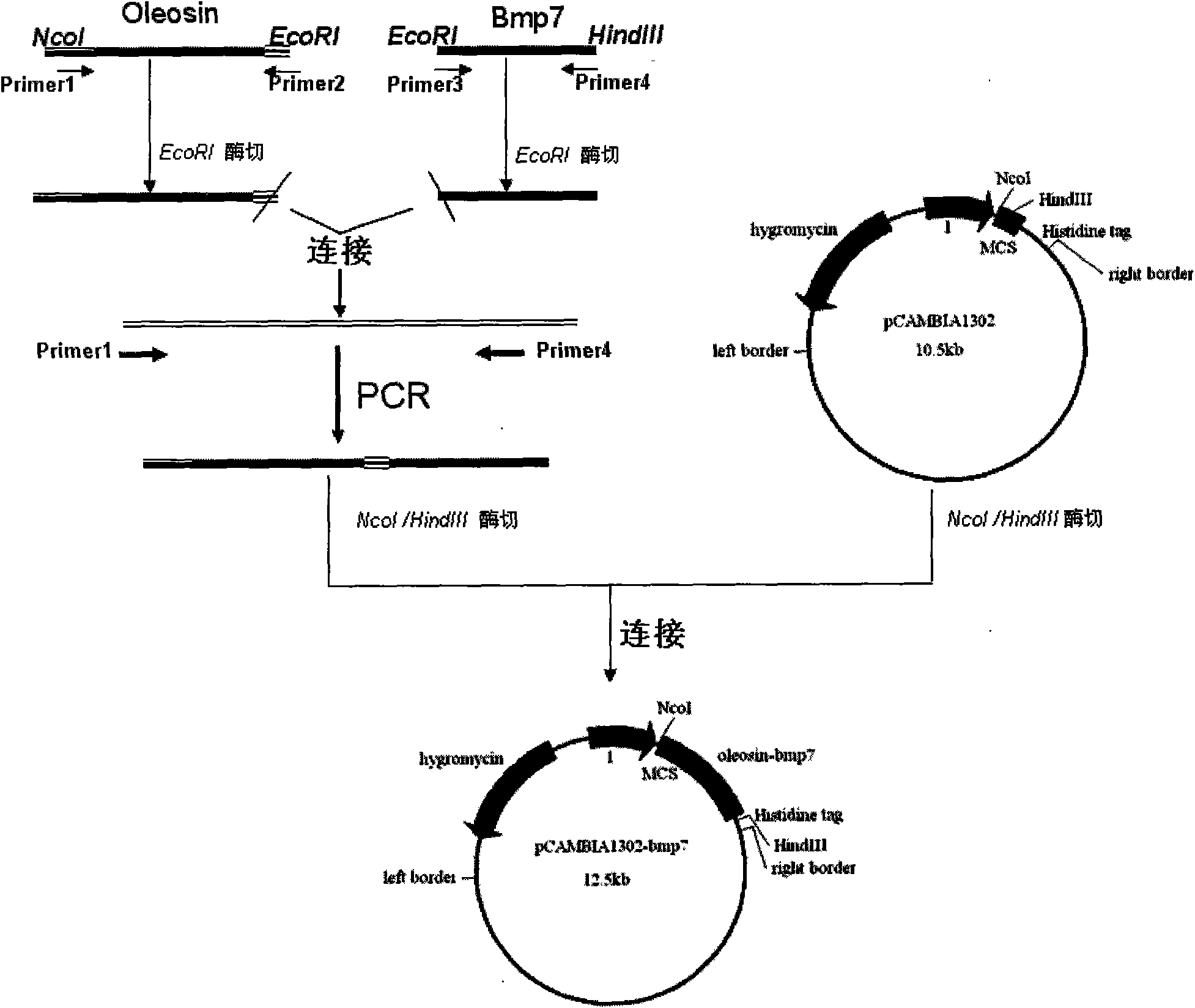Method for expressing human osteogenic protein-1 in peanut seeds
A technology of osteogenic protein and peanut, applied in the direction of animal/human protein, osteogenic protein, osteogenic factor, etc., to achieve the effect of simple method, convenient transportation and stable recombinant protein
- Summary
- Abstract
- Description
- Claims
- Application Information
AI Technical Summary
Problems solved by technology
Method used
Image
Examples
Embodiment 1
[0024] Example 1 Cloning of the soybean oleosin gene comprising a promoter
[0025] According to the sequence of the promoter of soybean oil body protein in NCBI and the gene sequence of oil body protein (gene accession number: GMU09118), the forward primer sequence containing the NcoI restriction site (CCATGG) was designed: primer1: 5'CATGCCATGGTGTTTATCTTTCTTGCTTTTCTG 3'; According to the open reading frame sequence of soybean oil body protein gene, the stop codon was removed, and the reverse primer primer2 with EcoRI restriction site (GAATTC) and enteropeptidase recognition site (TTATCATCATCATC) was designed: 5'CCGGAATTCCCTTATCATCATCATCTGCGGTTGCGGTTGTTGCTGTCA T 3 '.
[0026] Extract the genomic DNA of soybean (Zhonghuang 13), the method is as follows:
[0027] (1) Take 100 mg of young soybean leaves, grind them into powder with liquid nitrogen, or use them directly or store them at -80°C;
[0028](2) Preheat CTAB extract (0.2M Tris-HCl, pH 9.0; 0.4M LiCl; 25mM EDTA; 1% SDS...
Embodiment 2
[0042] Example 2 Acquisition of Human Osteogenic Protein Mature Peptide cDNA Gene bmp7
[0043] According to the mature peptide sequence of human osteogenic protein-1 gene in NCBI (gene accession number: NM_001719), primers containing EcoRI site primer3: 5'CCGAATTCATATGACCGGCAGCAAACAG 3' and primer4 with HindIII site: 5'GAAAGCTTGATCC TTACATGTCGCAGCCACAGGC 3' were designed .
[0044] collect 1x10 6 According to the standard procedure of One-Step RT-PCR Kit (Clonetech), the following PCR reactions were carried out: incubation at 45°C for 1h, denaturation at 45°C for 5min, annealing at 51°C for 1min, 72°C extension for 1 min) for 30 cycles, 72°C extension for 7 minutes.
[0045] 5 μL of the PCR product was subjected to 1% agarose gel electrophoresis, the results were observed under ultraviolet light, and positive clones were selected for sequencing (see Sequence Table 4).
Embodiment 3
[0046] The construction of embodiment 3 plant expression vectors
[0047] The construction process of plant expression vector is as follows: figure 1 Shown:
[0048] (1) Linkage of oleosin gene and human osteogenic protein gene (oleo-bmp7)
[0049] The PCR product was digested with the following system:
[0050] PCR product 10.0 μL, 10x Buffer H 3.0 μL, EcoRI 1.0 μL, ddH 2 O 16.0 μL. Incubate at 37°C for 4 hours, perform agarose electrophoresis, and recover oil body protein and osteogenic protein gene fragments respectively.
[0051] Ligate the oleosin gene and the human osteogenic protein gene with T4 DNA ligase: 1.0 μL of 10x T4DNA ligasebuffer, 4.0 μL of Oleosin, 4.0 μL of Bmp7, 1.0 μL of T4DNA ligase. Ligate overnight at 16°C, take 1.0 μL of the ligation product for PCR amplification, the system is as follows: 2x pfu mix 10.0 μl, primer1 (10 μm) 0.5 μl, primer4 (10 μm) 0.5 μl, ddH 2 O 8.0 μl. The PCR instrument (TaKaRa TP650) was set at 94°C for 5min, followed by 94...
PUM
 Login to View More
Login to View More Abstract
Description
Claims
Application Information
 Login to View More
Login to View More - R&D
- Intellectual Property
- Life Sciences
- Materials
- Tech Scout
- Unparalleled Data Quality
- Higher Quality Content
- 60% Fewer Hallucinations
Browse by: Latest US Patents, China's latest patents, Technical Efficacy Thesaurus, Application Domain, Technology Topic, Popular Technical Reports.
© 2025 PatSnap. All rights reserved.Legal|Privacy policy|Modern Slavery Act Transparency Statement|Sitemap|About US| Contact US: help@patsnap.com



